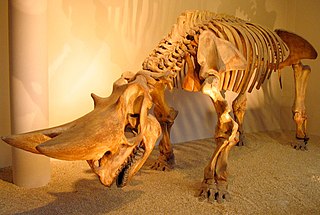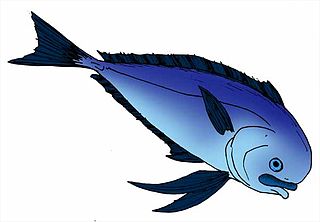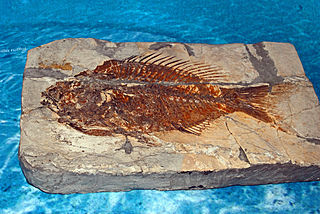
Arsinoitherium is an extinct genus of paenungulate mammals belonging to the extinct order Embrithopoda. It is related to elephants, sirenians, and hyraxes. Arsinoitheres were superficially rhinoceros-like herbivores that lived during the Late Eocene and the Early Oligocene of North Africa from 36 to 30 million years ago, in areas of tropical rainforest and at the margin of mangrove swamps. A species described in 2004, A. giganteum, lived in Ethiopia about 27 million years ago.
Phyllodus is an extinct genus of bony fish from the Maastrichtian to Middle Miocene. Fossils of the genus have been found in the Maastrichtian to Lancian Hell Creek Formation and the Eocene London Clay.

Kushlukia is an extinct genus of prehistoric bony fish, closely related to the luvar, that lived during the lower Eocene. K. permira is from Eocene portion of the Danata Formation Lagerstatten, of Turkmenistan. A second, as yet undescribed species is from the Fuller's Earth formation Lagerstatten in the Barmer District, of Ypresian Rajasthan, India.
Promegalops is an extinct genus of prehistoric bony fish that lived during the lower Eocene.
Protarpon is an extinct genus of prehistoric bony fish that lived during the lower Eocene.
Argilloberyx is an extinct genus of prehistoric marine bony fish that lived during the lower Eocene. It contains one species, A. prestwichae, known from the London Clay Formation on the Isle of Sheppey, United Kingdom. It is considered a member of the family Berycidae.
Berycomorus is an extinct genus of prehistoric marine ray-finned fish that lived during the late Eocene epoch. It contains a single species, B. firdoussi, from the Pabdeh Formation of Iran.

Balistomorphus is an extinct genus of prehistoric triggerfish during the early Oligocene epoch in what is now Canton Glarus, Switzerland. It inhabited the marine environment of the Tethys Ocean.

Eolactoria sorbinii is an extinct prehistoric boxfish that lived during the Lutetian epoch of the middle Eocene, in Monte Bolca. It had two pairs of long spines, one over each eye, and one pair beneath the anal and caudal fins, arranged very similarly to those possessed by the modern genus Lactoria, but were, in comparison, much longer. E. sorbinii had a fifth spine between the two eye-spines, arranged and looking very much like a nose.
Aglyptorhynchus is an extinct genus of prehistoric marine billfish that was distributed worldwide from the early Eocene to the early Miocene. Fossils are primarily known from the Northern Hemisphere, but one species is also known to have inhabited the waters off New Zealand.

Aluvarus praeimperialis is an extinct ray-finned fish, known from two headless fossil specimens found in the Pabdeh Formation, a Late Eocene stratum from the Priabonian epoch, of what is now Iran. A. praeimperialis was originally thought to be a luvar, described as "Luvarus praeimperialis", as it was thought to be a predecessor to the modern luvar. A later reexamination of the specimens showed that they were too incomplete to demonstrate such a conclusion and had no clear exclusive shared traits with luvar, and were renamed "Aluvarus", meaning "not luvar" or "different than luvar". However, some authorities still retain it as a luvar.
Carpathichthys is an extinct genus of prehistoric slickhead fish from the Oligocene. It contains a single species, C. polonicus, from the Menilite Formation in the Carpathian Flysch Belt of Poland, in what was formerly the Paratethys Sea.
Diaphyodus is an extinct genus of prehistoric marine ray-finned fish, generally considered a drumfish, from the Late Paleocene and Eocene, and potentially to the mid-Oligocene of Europe and North America.

Dapalis is an extinct genus of prehistoric glassfish known from the Late Cretaceous to the Early Miocene. It is known from both freshwater and marine habitats of India, Australia, New Zealand, and much of mainland Europe.

Cylindracanthus is an extinct, enigmatic genus of marine ray-finned fish with fossils known throughout North America, Europe, Asia and Africa from the Late Cretaceous to the late Eocene, with potential Oligocene records and a possible Miocene record also known. It is exclusively known from its distinctive partial remains, which are long cylindrical bony spines that are usually considered rostrum fragments, as well as some associated teeth. These spines are abundant & widespread throughout this timespan, and are useful indicators of a nearshore marine environment, but the taxonomic identity of the fish is still highly uncertain and debated.

Sparnodus is an extinct genus of prehistoric perciform fish in the family Sparidae. Species of this genus were nektonic carnivores. These fishes lived in the Cenozoic Era, in the Oligocene and Paleocene.
Palaeogadus is an extinct genus of prehistoric bony fish. It was a nektonic carnivore found in coastal and estuarine marine environments, with fossils found from the Oligocene to Miocene at sites in Denmark, Germany, Poland, Georgia, and Azerbaijan.

Palimphyes is an extinct genus of prehistoric euzaphlegid bony fish related to the escolars and snake mackerels. The various species lived as deepwater mesopelagic predators in the Tethys and Paratethys oceans, with fossils of ten species found in Paleocene to Oligocene strata of the Swiss Alps, the Carpathian and Caucasus Mountains, Iran, India, and Turkmenistan.

Phareodus is a genus of freshwater fish from the Paleocene to the Eocene of Australia, Europe and North and South America.
Xiphiorhynchoides is an extinct genus of swordfish from the Oligocene of Austria. Its fossils have been found in the Paisslberg Formation in Tyrol, which is thought to represent a deepwater environment close to the shore. It is the best preserved member of the Xiphiorhynchinae and known from a single species: X. haeringensis. The name derives from the town of Bad Häring.










